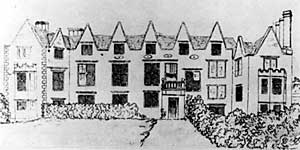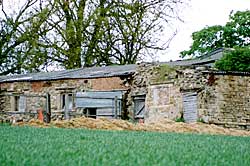Selston Old Hall
BY THE LATE WILLIAM STEVENSON.

ALTHOUGH I have lived for thirteen years within a few miles of Selston, a township on the borders of Nottinghamshire and Derbyshire, and taken an active interest in old-time buildings, it is only quite lately (1919) that I have learnt that an important Tudor mansion or hall existed there down to a century ago, when it so silently disappeared that its very memory had passed away before the advent of this century.
My enlightenment came when a friend presented me with an engraving said to be of “Selston Old Hall.” As neither Dr. Thoroton nor later writers mentioned it, I had doubts on the subject which led to a visit of inquiry and exploration to a small farmstead that bears the “hall” name if not the hall-mark.
It is a plain modern erection on a hill top in the north of the township, situated about half way between Selston Church and Pinxton station, a fine commanding site, though now robbed of its beauty by the immense coffiery works at the station side. It still contains the last relic of the old hall, in a fine oak staircase with elaborate newel-post, 7ft. in height and 8in, square.
The house has a south aspect that takes in a garden and a grass field, the dividing line being an ancient brick-wall through which is a wrought stone entrance gateway of considerable architectural pretensions, but now in a state of decay.

Engraving of Selston Old Hall.
The engraving of the old hall has not much merit as a work of art, but it is all that time has vouchsafed to us, and we must be thankful for small mercies. There is no legend on the engraving, of which only two other impressions are known to exist. The owners of these hold them to be south-east prospects of Selston Old Hall. The lower left hand corner is inscribed “C. A. Coke, pinx,” and the lower right hand corner ‘E. T. Coke, 45th sculp.” These are clearly two members of the old Derbyshire Coke family, one of whose estates and residence is Brookhill in Pinxton, the neighbouring manor to the north of Selston.
The service which this print has done is to prove through the drawing of the low enclosing wall and the gateway, that we have here a picture of the old hall—one that should have been drawn by an earlier artist to have illustrated Dr. Thoroton’s great work of 1677. On identifying the picture as that of the lost hall, through the medium of the mined or disused garden entrance I had photographs of the gateway taken by a friend at Codnor (Mr. J. A. Langton) with the view to submitting the whole subject to Mr. J. A. Gotch, the great authority on Renaissance architecture in England. They are south west views, showing the ground raised a foot or more by garden rubbish, etc., in which one of the surmounting balls now lies all but buried; the other three still hold theft original positions, although the upper third of each elaborate jamb is being tilted almost to its fall, by the corroding expansion of the great iron gate-hooks.
The plan of this construction is a pair of rebated “built-up” Mansfield Woodhouse yellow magnesian limestone gate-jambs recessed in three stages, each faced with a half round attached pilaster having a moulded base, agreeing in design and detail with the gate jamb until the cap of the jamb is reached when it begins to assert its independence and becomes a circular column with a cap neck-mould, square abacus, and ball terminal, which on the whole produces a pleasing composition and shows the designing hand of an architect of high merit. Whether the Hall was the work of the same artist cannot now be said, but Mr. Gotch’s opinion is here quoted:

“The gate-piers are somewhat uncommon in treatment and may well have been designed by one of the Smithsons, although I do not think that any of Smithson’s extant drawings are just like them.
“The etching is very interesting, but it does not throw much light on the architectural detail, and I should doubt, taking the rest of the work into consideration, whether it is any earlier than the rest of the house, which is evidently either Elizabethan or Jacobean—probably the latter.
“The newel points to the staircase having been more elaborate than usual.”
Having pursued the subject thus far it may not be out of place to close with a few historical notes.
Thoroton informs us that this manor was the property of the Jay family, and that it passed in Elizabeth’s time by purchase to Timothy Pusey of the ancient Berkshire family of that name. Timothy married Maria, daughter and co-heir of John Clay, and their issue was two daughters, Sarah Pusey married to Gervase Clifton, natural son of Sir Gervase Clifton, Bart, of Clifton; she died on January 22nd, 1652, and lies buried at Clifton, Notts.; Elizabeth Pusey (died 1659), married to William Willoughby, Esq. She had this Seiston estate. Their issue was William Willoughby, Bart, of Selston, and Maria Willoughby, who married Beaumont Dixie, Esq. This William Willoughby was a very rich resident at the Hall, who dying on February 10th, 1670, without lawful issue, gave his South Muskham estate to his kinsman, Francis Willoughby, the philosopher, who recorded that bequest on a tablet in Wollaton Church, of which Collins (Peerage vii. 218) gives the lengthy inscription.

Possible remains of Selston Old Hall incorporated in outbuildings on the site (photo: A Nicholson, 2003).
This last of the Willoughbys of Selston was buried with great pomp three months after his decease, and his helmet and knightly banner still hang in Selston Church as records of that old time event. On his death Selston estate and hall passed to the Dixie family who still have interests there.
The engraving referred to in Mr. Stevenson’s paper was reproduced to illustrate an anonymous article on Selston Old Hall, in the “Nottinghamshire Guardian,” September 7th, 1907.—Ed.
